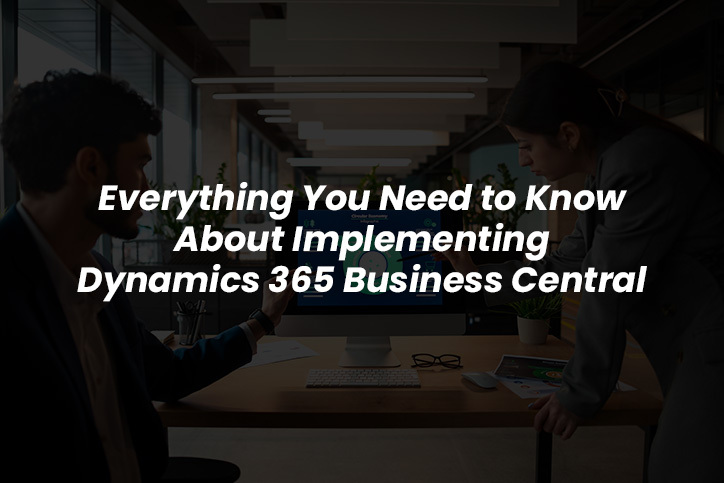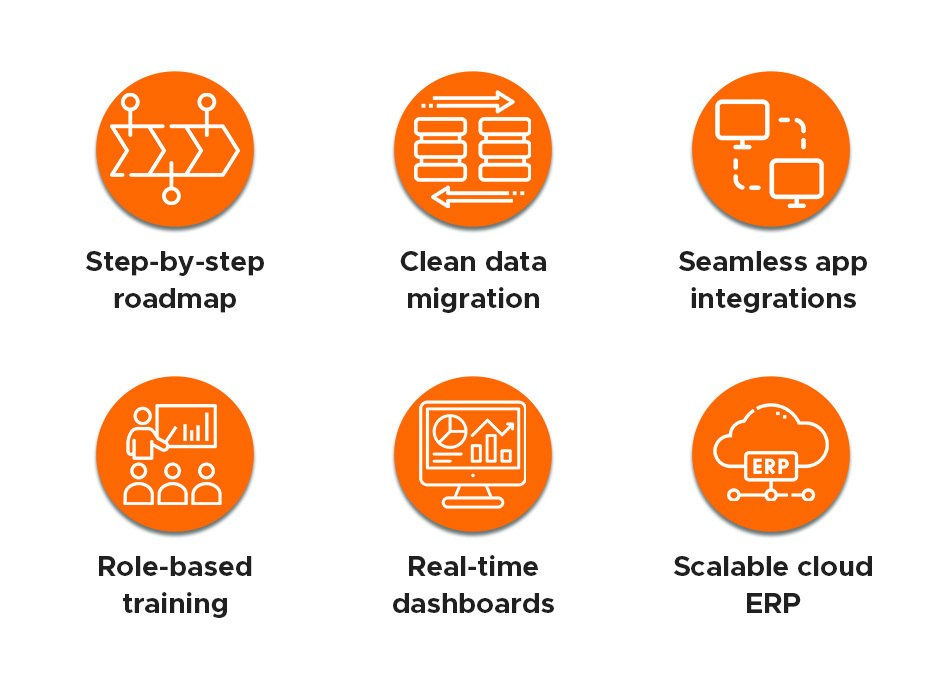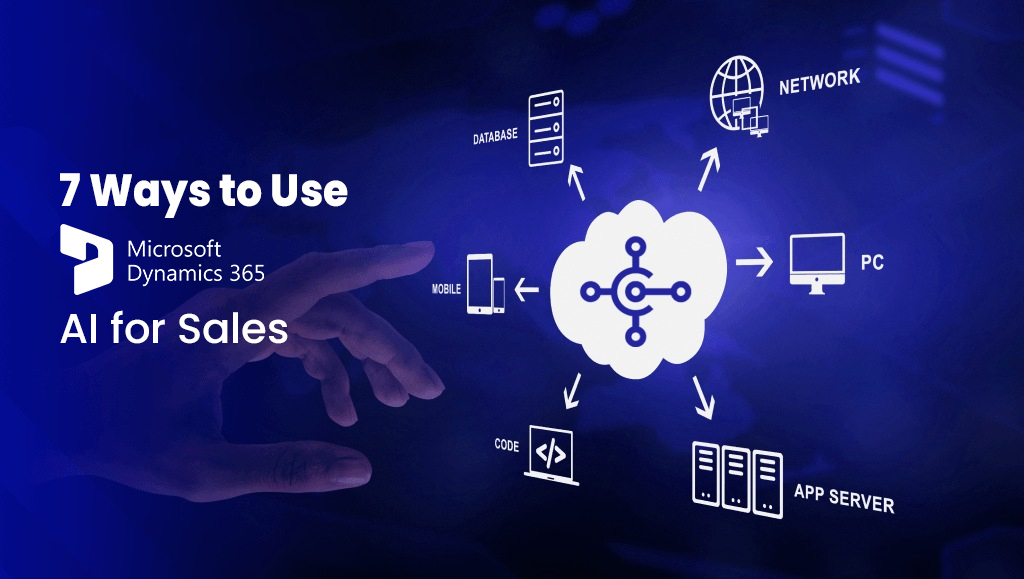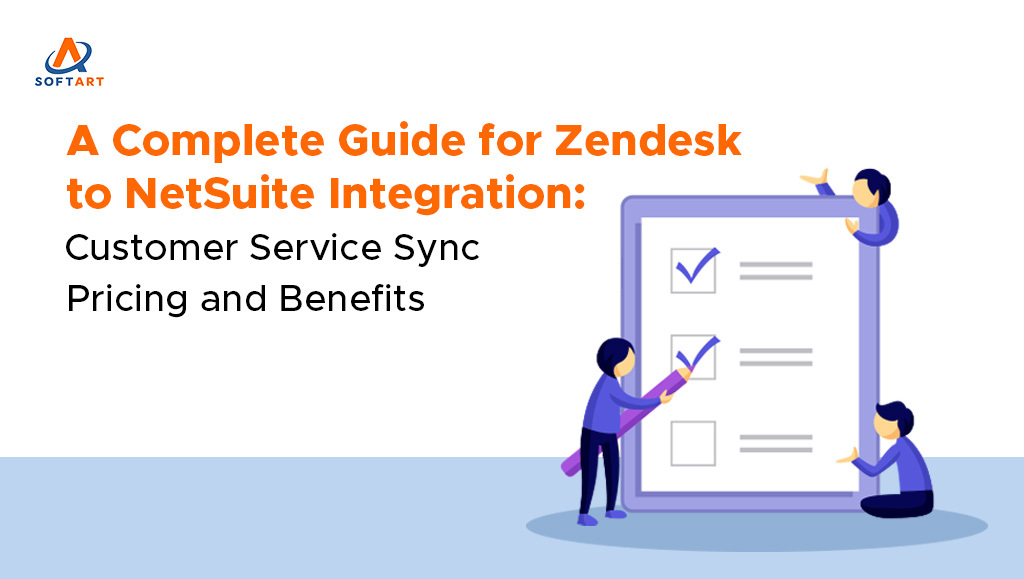Planning to implement Dynamics 365 Business Central but not sure from where to begin? This blog is here at your rescue. We break down the full Dynamics 365 business central implementation process step by step, outline what to expect during a Dynamics 365 Business Central implementation, and share best practices for a seamless transition.
Whether you’re upgrading from a legacy system or moving to the cloud, this guide will help you make informed decisions. Read on to learn how to implement Dynamics 365 Business Central step by step and set the foundation for long-term success.
Why Choose Dynamics 365 Business Central?
Dynamics 365 Business Central is a modern, scalable, and cloud-based ERP solution designed for small to mid-sized businesses. It unifies core business functions like finance, operations, sales, inventory, and customer service into one seamless platform.
Key benefits:
- Centralized operations and data workflows that eliminate silos.
- Real-time insights and decision-making powered by built-in analytics.
- Seamless integration with Microsoft 365, Teams, and Power Platform.
- Automated processes that reduce manual work and improve efficiency.
- Scalable infrastructure that grows with your business.
- Enhanced compliance and audit-readiness.
This ERP helps you streamline operations, improve collaboration, and reduce overheads — all within a unified Microsoft ecosystem.
Step-by-Step Guide: How to Implement Dynamics 365 Business Central
Understanding how to implement Dynamics 365 Business Central step by step is essential for a successful rollout. Here’s how to do it right.
1. Initial Assessment and Business Readiness
Begin by evaluating where your business stands.
- Identify key business objectives you want to achieve with Business Central.
- Assess your current systems and workflows for gaps and inefficiencies.
- Gather input from all departments like finance, sales, HR, operations, and logistics.
- Prepare a Business requirement document internally before hunting for partners
- Define KPIs that will track your success post-implementation.
- Check your IT infrastructure’s readiness for a cloud-based ERP.
2. Choose the Right D365 Implementation Partner
This is a mission-critical phase. A proven provider of Dynamics 365 Implementation services like SoftArt ensures you don’t just install an ERP — you embed a scalable, smart business strategy.
Look for partners who:
- Have certified Microsoft Dynamics 365 consultants.
- Offer post-implementation support and training.
- Understand your industry and business nuances.
- Can deliver customized workflows tailored to your needs.
3. Define Project Scope and Planning
Every implementation needs a roadmap.
- Finalize which modules you’ll implement (Finance, Inventory, Sales, etc.).
- Set a timeline with key milestones and deliverables.
- Establish governance and reporting structures.
- Assign ownership and accountability for internal and external teams.
- Based on the Business Requirement document you have prepared the partner should respond with the fitgap analysis document mapping whether all functionalities are covered as part of the standard out of the box, Customizations, Not possible and out of scope.
A detailed project plan prevents scope creep and helps manage stakeholder expectations.
4. Opt for Data Cleansing and Migration
Data is the engine of your ERP system. A messy database leads to a chaotic ERP.
- Audit your data for duplicates, inaccuracies, or missing values.
- Map existing records to Business Central’s structure.
- Run test migrations in a sandbox before go-live.
- Back up everything and validate migrated data thoroughly.
Proper data migration reduces errors and builds trust in the system from day one.
5. Tailor System Configuration and Customization
Time to tailor Business Central to your workflows.
- Configure key modules such as General Ledger, Bank Management, Sales, and Purchase. and other modules which were agreed as part of the scope by the partner
- Assign permissions based on roles and responsibilities.
- Set up localized tax and regulatory requirements.
- Integrate legacy tools or third-party apps using Dynamics 365 Business Central integration services.
This ensures your ERP system adapts to your business, not the other way around.
6. Opt for Testing and User Training
Data is the engine of your ERP system. A messy database leads to a chaotic ERP.
- Audit your data for duplicates, inaccuracies, or missing values before sharing the final Opening balances to the partner.
- Only bring open transactions, Open order and Opening balances to the new system
- Run test migrations in a sandbox before go-live.
- Back up everything and validate migrated data thoroughly.
- Create a strategy where to park the historic data from the legacy system its not recommended to bring the historic data to the new system, if historic data migration is a must then this has to be a separate project and before go live all the historic data to be validated year by year and once all the books are closed only then the go live will be possible.
High adoption starts with high understanding. Never underestimate the power of good training.
7. Go Live and Post-Go-Live Support
With everything tested and trained, you’re ready to go live.
- Use a phased rollout or big bang approach depending on business size.
- Monitor dashboards, reports, and real-time data.
- Offer a support desk to resolve user issues quickly.
- Collect post-go-live feedback to plan enhancements.
Post-launch support is where you start seeing the real ROI.
What to Expect During a Dynamics 365 Business Central Implementation?
Implementing an ERP is a transformation process and is not just a tech upgrade.
You should expect:
- Internal resistance to new processes from some teams.
- Delays due to data or integration challenges.
- Gradual performance improvement over 3 to 6 months.
- Enhanced visibility, reduced silos, and better controls long term.
Stay flexible, patient, and ready to adapt. Aligning change management early will save you downstream chaos.
Common D365 Implementation Challenges and Solutions
During the Dynamics 365 implementation process, you may face a few challenges. Here’s an overview of the challenges and the solutions to overcome them!
# Challenge 1 – Incomplete Requirement Gathering.
- Solution: Involve every stakeholder group early. Conduct workshops and document use cases thoroughly.
#Challenge 2 – Poor Data Quality.
- Solution: Dedicate time to cleaning and restructuring data before migration.
#Challenge 3 – Integration Gaps.
- Solution: Use structured Dynamics 365 Business Central integration services to connect existing systems securely and efficiently.
#Challenge 4 – Lack of User Adoption:
- Solution: Provide continuous learning, access to guides, and a helpdesk. Train your internal super-users.
Best Practices for Implementation Success
Implementing Business Central is easier when you:
- Begin with a pilot to test modules in real conditions.
- Use agile sprints for fast feedback and iteration.
- Assign internal champions in every department.
- Build dashboards and KPI monitors early to prove value.
- Regularly communicate progress to stakeholders.
Your implementation doesn’t end at go-live, it evolves.
The Role of Integration in ERP Success
Your ERP (Dynamic 365) doesn’t live in a vacuum. Effective integration multiplies its impact. Leverage Dynamics 365 Business Central integration services to connect with:
- Microsoft 365 for seamless productivity (Outlook, Excel, Teams).
- Power BI for customized dashboards.
- E-commerce platforms like Shopify.
- Payment gateways and POS systems.
- CRM tools like HubSpot or Dynamics 365 Sales.
- Integrations with Government bodies like for E-Invoicing & Tax authorities
These integrations boost automation, reduce manual errors, and ensure consistent data across the board.
Cost and Timeline Estimates
While every implementation is unique, here’s an integration timeline guide and cost estimate details.
| Business Size | Timeline | Cost Estimate |
|---|---|---|
| Small (1 – 20 users) | 3-4 months | $20,000 – $50,000 |
| Medium (20-100 users) | 6-8 months | $50,000 – $1,50,000 |
| Enterprise (100+ users) | 9-12 months | $1,50,000 – $500,000+ |
Costs vary based on customization needs, data volume, user licenses, and integration complexity.
Build a Smarter, Connected Business!
A well-planned Dynamics 365 Business Central implementation empowers your teams, enhances decision-making, and gives you real-time control over your operations. It streamlines processes today while preparing you for tomorrow.
With expert guidance from SoftArt, your ERP journey is backed by experience, strategy, and seamless execution. Ready to take the next step?
Plan your ERP journey with clarity and move toward a smarter, more agile business future.
Book a Call With our Integration Experts Now!
Frequently Asked Questions:
Q1. What is Dynamics 365 Business Central used for?
Ans. Dynamics 365 Business Central is a cloud-based ERP solution that helps businesses manage core operations such as finance, sales, supply chain, customer service, and project management from a unified platform.
Q2. How long does it take to implement Dynamics 365 Business Central?
Ans. Implementation timelines vary based on business size and complexity. A small business may go live within 2–3 months, while medium to large businesses may take 6–12 months.
Q3. What are the key steps in a Business Central implementation?
Ans. The main stages include business assessment, partner selection, scoping and planning, data migration, system configuration, training, testing, and post-go-live support.
Q4. Do I need an implementation partner for Dynamics 365 Business Central?
Ans. Yes, working with an experienced partner like SoftArt ensures your implementation is tailored, technically sound, and aligned with best practices, reducing risks and delays.
Q5. Can Business Central integrate with my existing tools and software?
Ans. Absolutely. With Dynamics 365 Business Central integration services, you can connect with Microsoft 365, Power BI, CRMs, eCommerce platforms, payment gateways, and more for end-to-end automation.







![Duplicate Data in Dynamics 365 [What It Costs and How to Fix It]!](https://softartsolutionsinc.com/wp-content/uploads/2025/12/duplicate-data-in-dynamics-365-what-it-costs-and-how-to-fix-it.jpg)

